Patient Information Booklets

Bowel Preparation
This preparation is crucial for reducing the risk of long-term side effects on the bowels and ensuring treatment efficacy. It includes dietary guidelines to reduce gas and bloating, such as consuming small meals, avoiding gas-forming foods, and staying active to promote regular bowel movements.
Read More
A Guide to Chemotherapy
Chemotherapy (also called chemo) is a type of cancer treatment that uses drugs to destroy cancer cells. Many types of drugs are used in chemotherapy, all of which destroys cancer cells in different ways. It is a systemic therapy, meaning it affects the entire body.
Read More Read More (Chinese Version)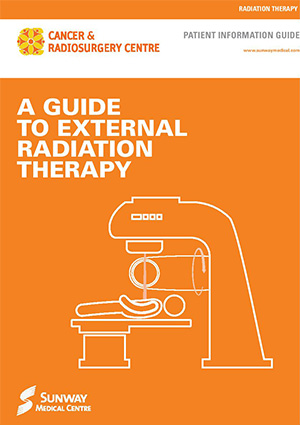
A Guide to External Radiation Therapy
Radiation therapy (radiotherapy) is a cancer treatment that uses high doses of radiation to kill cancer cells and stop them from spreading. At low doses, radiation is used as an x-ray to see inside your body and take images.
Radiation therapy does not kill cancer cells immediately. It takes days or weeks of treatment before cancer cells start to die. After that, cancer cells keep dying for weeks or months after radiation therapy end.
Radiation therapy can be external beam (when a machine outside your body aims radiation at cancer cells) or internal (when radiation is put inside your body, in or near the cancer cells).
Read More
Behavioural Health
Behavioural Health Centre advocates a holistic approach to healthcare by nurturing the psychosocial aspects of physical illness. We believe that health is a state of body and mind WELLNESS. It is essential to nourish our THOUGHTS, EMOTIONS AND BEHAVIOURS to produce better physical and mental health. We will help you to thrive and lead a healthier, fuller life.
Read More
Bladder & Bowel Preparation for Radiotherapy to the Pelvis
To ensure that the irradiation area is in the same position during treatment as it was in the CT scan, you will be advised to have an empty bowel and a comfortably full bladder for each appointment.
Read More
Cancer Treatment: Brachytherapy
Brachytherapy is a type of radiotherapy treatment which uses a radioactive source placed close to the tumour. It can deliver high doses of radiation to specific sites quickly.
Read More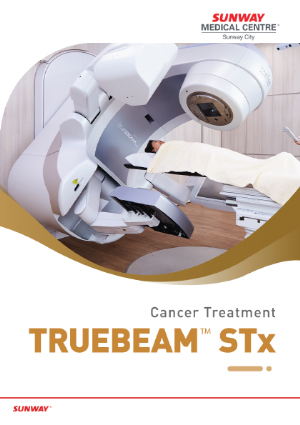
Cancer Treatment: TrueBeam™ STx
The advanced radiotherapy system offers sophisticated imaging and motion management, sub-milimitre dosage delivery accuracy, and rotating ability to give fast and powerful treatments that often last only a few minutes.
Read More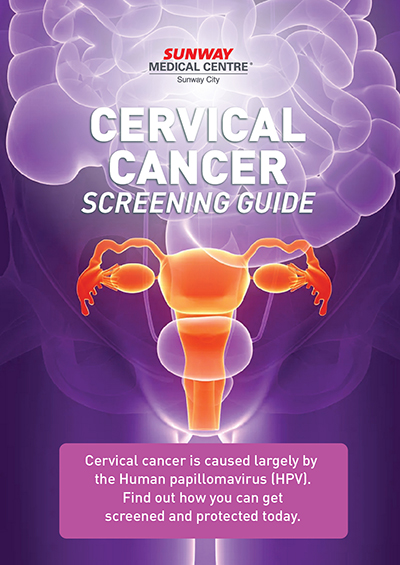
Cervical Cancer Screening Guide
Cervical cancer is caused largely by the Human papillomavirus (HPV). Find out how you can get screened and protected today.
Read More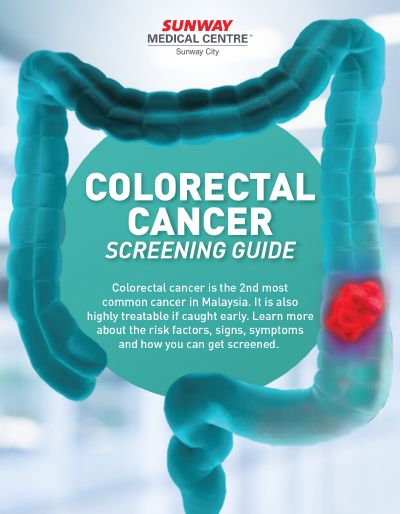
Colorectal Cancer Screening Guide
Colorectal cancer is the 2nd most common canceer in Malaysia. It is also highly treatable if caught early. Learn more about the risk factors, signs, symptoms and how you get screened.
Read More
Da Vinci Surgical System
The da Vinci Surgical System allows surgeons to perform complex minimally-invasive surgical procedures with precision and accuracy.
Read More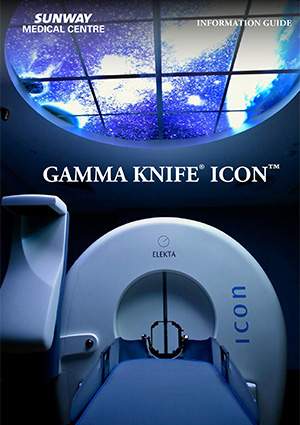
Gamma Knife
More than 80,000 patients undergo Gamma Knife surgery every year.
Regarded as the Gold Standard in intracranial radiosurgery, it is preferred for its extreme accuracy, efficiency and outstanding therapeutic response.
2 to 4 times better sparing of normal brain tissue compared with other stereotactic platforms.
Up to 130 times lower dose to the rest of the body compared with traditional linear accelerates.
Read More Read More (Chinese Version)
Hyperthyroidism
The thyroid is a small gland in your neck, in front of your windpipe. It produces a hormone called thyroxine which regulates the body's metabolism. Hyperthyroidism is a medical condition of overactive thyroid gland, which leads to excessive thyroxine hormone secretion.
Common causes of hyperthyroidism are autoimmune condition known as Graves' disease (when your body immunity acts against your own body) and benign single or multi nodular goiter.
Read More Read More (Chinese Version)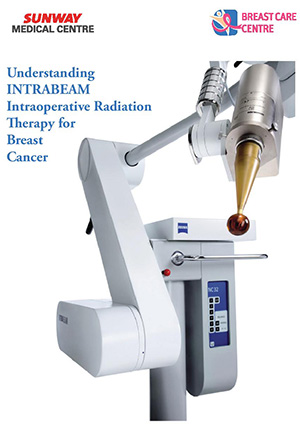
IORT
IORT stands for Intraoperative Radiotherapy. IORT is a technique of delivering radiotherapy directly to the tissues surrounding the cancer (also known as tumour bed) during surgery. This new technique will greatly reduce radiation exposure and the length of treatment time
INTRABEAM IORT is delivered during breast conservation surgery (also known as lumpectomy) in the operating room while the patient is still asleep. After the tumour is removed, a miniaturised radiation device is inserted into the lumpectomy cavity. Therapeutic radiation is then directed immediately and precisely where it is needed most – the location where the cancer was removed. Localising the radiation inside the breast is effective because this is where the cancer is most likely to recur. INTRABEAM IORT is delivered as a 30-45 minute treatment during surgery.
Read More Read More (Chinese Version)
Kidney Cancer Treatment with da Vinci Surgical System
There are many different types of kidney cancer. The most common type is renal cell carcinoma which accounts for more than 80% of all kidney cancers. The good news is that most of kidney cancers are found before they spread (metastasise) to other organs. Cancers that are detected early can be treated with better success rate.
Read More
Living with Head and Neck Cancers
When someone mentions cancer, head and neck cancers rarely come to mind. Despite that, head and neck cancers are very common in Malaysia. This type of cancer generally forms in the squamous cells (cells that line the moist mucosal areas in the head and neck).
Read More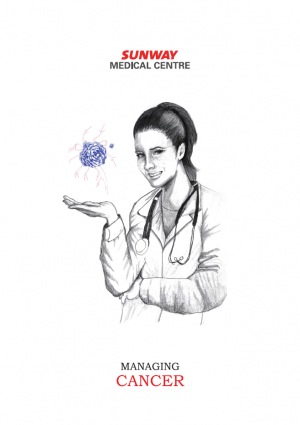
Managing Cancer
Among the many contributions of innovation and technology is the ability to provide better treatment options in the healthcare industry. One of the key areas technology has made an impact in is the treatment of cancer.
Although the cause of cancer is uncertain, with technology today, managing cancer has become less challenging.
Read more about the different areas involved in healthcare that supports the management of cancer in the link below.
Read More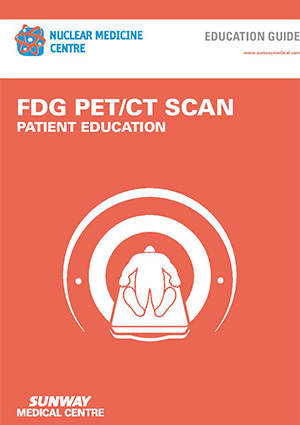
PET/CT Scan
FDG PET/CT (Positron Emission Tomography/Computed Tomography) is a powerful imaging technique that combines both CT scan and PET scan using radioactive sugar (FDG – 18F-fluorodeoxyglucose) as the tracer.
It provides comprehensive information on the abnormal activity and function of cells (obtained by PET) as well as the precise location of these abnormalities in the body (obtained by CT).
This leads to more accurate assessment of your current medical condition especially cancer, brain disorder, heart disease and infective/ inflammatory disease.
Read More Read More (Chinese Version)
Prostate Cancer Treatment with da Vinci Surgical System
Prostate cancer occurs in the prostate gland when abnormal cells develop in the prostate. It is one of the more common cancers globally and usually affects men aged 50 and above. Prostate cancer is generally a slow growing disease and often has no early symptoms.
Read More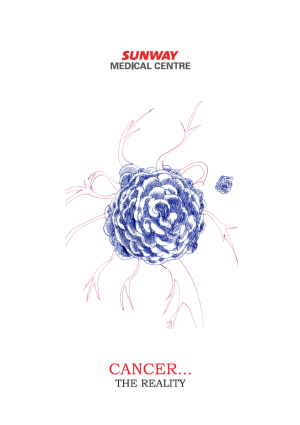
The Reality of Cancer
Our cells are the building blocks of our body and when the growth process of these cells go wrong, it forms a mass called a tumour. A malignant tumour is cancerous and there are more than a hundred types of cancer with symptoms that vary depending on the type.
In Malaysia, cancer is considered the most lethal killer disease among all, with several types of cancer being the main contributors to the high mortality rate each year.
Read More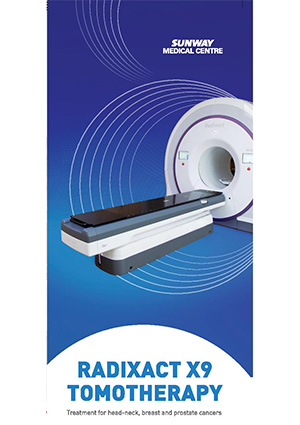
Tomotherapy Radixact-X9
Tomotherapy is a new way of treating cancer with radiation. It combines three elements into one integrated system.
Tomotherapy is both a treatment delivery machine and a CT scanner that allows experts to take a CT scan right before each cancer treatment.
Tomotherapy Radixact-X9 is an emerging modality or radiotherapy which controls and destroys malignant cells with high intensity radiation.
Read MorePoster Presentation
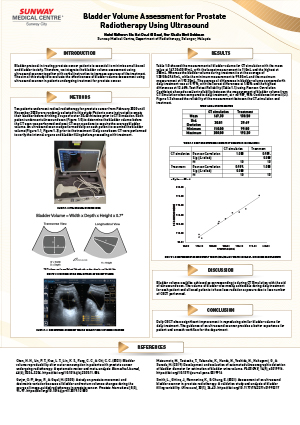
Bladder Volume Assessment for Prostate Radiotherapy Using Ultrasound
Bladder protocol in treating prostate cancer patients is essential to minimize small bowel and bladder toxicity. Therefore, we integrate the bladder volume assessment using ultrasound scanner together with verbal instruction to increase accuracy of the treatment. The aim of this study is to evaluate the effectiveness of bladder volume assessment using ultrasound scanner in patients undergoing treatment for prostate cancer.
Read More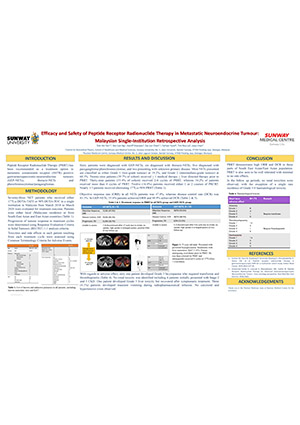
Efficacy and Safety of Peptide Receptor Radionuclide Therapy in Metastatic Neuroendocrine Tumour: Malaysian Single Institution Retrospective Analysis
Peptide Receptor Radionuclide Therapy (PRRT) has been recommended as a treatment option in metastatic somatostatin receptor (SSTR) positive gastroenteropancreatic-neuroendocrine tumours (GEP-NETs), thoracic-NETs and pheochromocytomas/paragangliomas.
Read More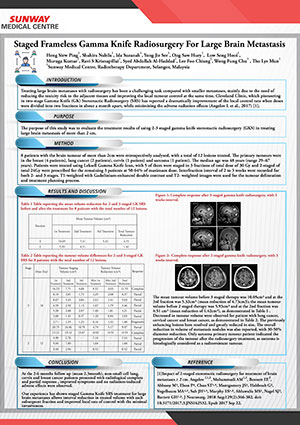
Gamma Knife Radiosurgery
Treating large brain metastases with radiosurgery has been a challenging task compared with smaller metastases, mainly due to the need of reducing the toxicity risk to the adjacent tissues and improving the local tumour control at the same time.
Cleveland Clinic, which pioneering in two-stage Gamma Knife (GK) Stereotactic Radiosurgery (SRS) has reported a dramatically improvement of the local control rate when doses were divided into two fractions in about a month apart, while minimising the adverse radiation effects (Angelov L et al., 2017) [1].
Read More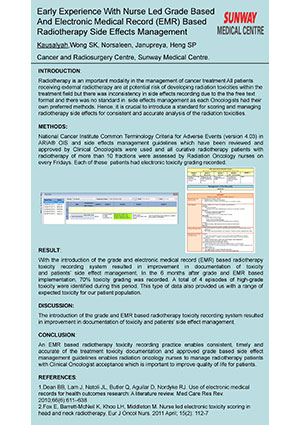
Nurse Lead Grade Based Radiotherapy Side Effect Management
Radiotherapy is an important modality in the management of cancer treatment. All patients receiving external radiotherapy are at potential risk of developing radiation toxicities within the treatment field but there was inconsistency in side effects recording due to the the free text format and there was no standard in side effects management as each Oncologists had their own preferred methods.
Hence, it is crucial to introduce a standard for scoring and managing radiotherapy side effects for consistent and accurate analysis of the radiation toxicities.
Read More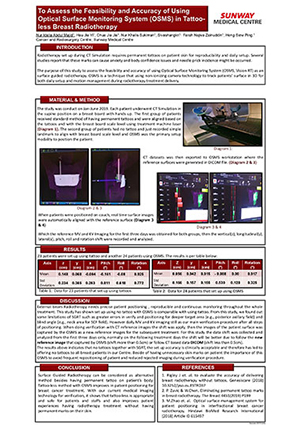
Optical Surface Monitoring System
Radiotherapy set up during CT Simulation requires permanent tattoos on patient skin for reproducibility and daily setup Several studies report that these marks can cause anxiety and body confidence issues and needle prick incidence might be occurred.
The purpose of this study to assess the feasibility and accuracy of using Optical Surface Monitoring System (Vision RT) as an surface guided radiotherapy OSMS is a technique that using non ionizing camera technology to track patients’ surface in 3 D for both daily setup and motion management during radiotherapy treatment delivery.
Read More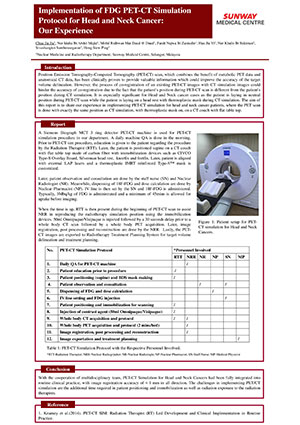
PET/CT Simulation
Positron Emission Tomography Computed Tomography (PET CT) scan, which combines the benefit of metabolic PET data and anatomical CT data, has been clinically proven to provide valuable information which could improve the accuracy of the target volume delineation.
However, the process of co registration of an existing PET CT images with CT simulation images could hinder the accuracy of co registration due to the fact that the patient’s position during PET CT scan is different from the patient's position during CT simulation.
Read More
Phantom Validation Of Geometric Accuracies of 3T MRI
Increasing the MRI field strength may enhance visualization and resolution of small brain lesions, in turn improving the accuracy of GKRS delivery.
However, concerns remain regarding the influence on geometric distortion caused by the metallic stereotactic skull frame, posts and fixation screws in a frame based Gamma Knife Radiosurgery.
Read More
Radioactive Iodine (RAI)
Radioactive iodine (RAI), also known as I-131, is used following surgery for certain types of thyroid cancer; specifically, follicular and papillary and hyperthyroidism.
The physical properties of iodine as well as its beta particle emission makes it an ideal agent that is specifically absorbed by the thyroidal cell and subsequently results in radiation-induced cellular apoptosis.
Read More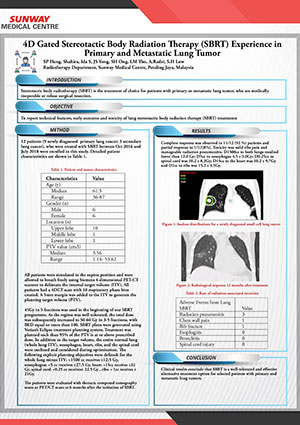
Stereotactic Body Radiation Therapy in Lung Tumour
Stereotactic body radiotherapy (SBRT) is the treatment of choice for patients with primary or metastatic lung tumor, who are medically inoperable or refuse surgical resection.
Read More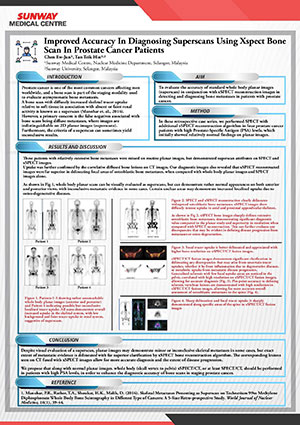
XSpect Bone Scan
Prostate cancer is one of the most common cancers affecting men worldwide, and a bone scan is part of the staging modality used to evaluate asymptomatic bone metastasis.
A bone scan with diffusely increased skeletal tracer uptake relative to soft tissue in association with absent or faint renal activity is known as a superscan (Manohar et. al., 2016).
Read More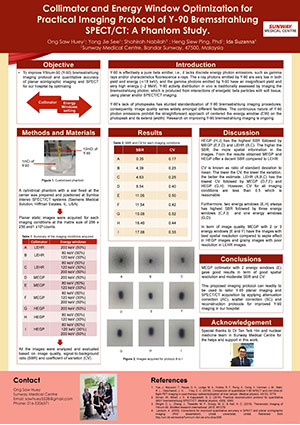
Y-90 bremsstrahlung SPECT/CT
Y-90 is effectively a pure beta emitter, i.e., it lacks discrete energy photon emissions, such as gamma rays and/or characteristics fluorescence x-rays. The x-ray photon emitted by Y-90 are very low in both yield and energy (<< 18 keV), and the gamma photons emitted by Y-90 have an insignificant yield and very high energy (~2 MeV).
Y-90 activity distribution in vivo is traditionally assessed by imaging the bremsstrahlung photon, which is produced from interactions of energetic beta particles with soft tissue, using planar and/or SPECT/CT imaging.
Read MoreJournal Articles
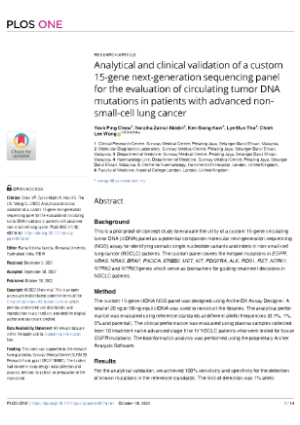
Analytical and Clinical Validation of a Custom 15-Gene Next-Generation Sequencing Panel for the Evaluation of Circulating Tumour DNA Mutations in Patients with Advanced Non-Small-Cell Lung Cancer
This is a pilot proof-of-concept study to evaluate the utility of a custom 15-gene circulating tumour DNA (ctDNA) panel as a potential companion molecular next-generation sequencing (NGS) assay for identifying somatic single nucleotide variants and indels in non-small-cell lung cancer (NSCLC) patients. The custom panel covers the hotspot mutations in EGFR, KRAS, NRAS, BRAF, PIK3CA, ERBB2, MET, KIT, PDGFRA, ALK, ROS1, RET, NTRK1, NTRK2 and NTRK3 genes which serve as biomarkers for guiding treatment decisions in NSCLC patients.
Read More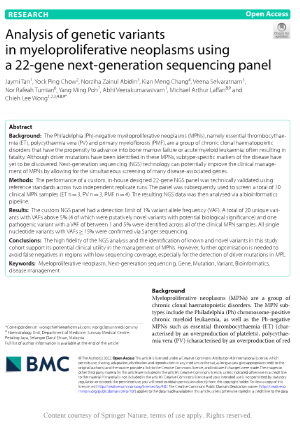
Analysis of Genetic Variants in Myeloproliferative Neoplasms Using a 22-Gene Next‑Generation Sequencing Panel
The Philadelphia (Ph)-negative myeloproliferative neoplasms (MPNs), namely essential thrombocythaemia (ET), polycythaemia vera (PV) and primary myelofibrosis (PMF), are a group of chronic clonal haematopoietic disorders that have the propensity to advance into bone marrow failure or acute myeloid leukaemia; often resulting in fatality. Although driver mutations have been identified in these MPNs, subtype-specific markers of the disease have yet to be discovered. Next-generation sequencing (NGS) technology can potentially improve the clinical management of MPNs by allowing for the simultaneous screening of many disease-associated genes.
Read More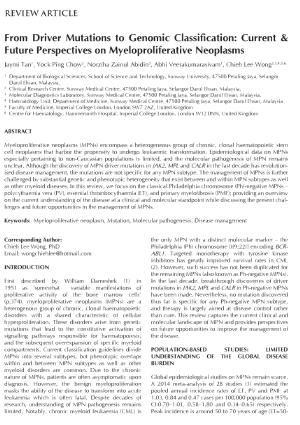
From Driver Mutations to Genomic Classification: Current & Future Perspectives on Myeloproliferative Neoplasms
Myeloproliferative neoplasms (MPNs) encompass a heterogeneous group of chronic, clonal haematopoietic stem cell neoplasms that harbour the propensity to undergo leukaemic transformation.
In this review, we focus on the classical Philadelphia chromosome (Ph)-negative MPNs – polycythaemia vera (PV), essential thrombocythaemia (ET), and primary myelofibrosis (PMF); providing an overview of the current understanding of the disease at a clinical and molecular standpoint while discussing the present challenges and future opportunities in the management of MPNs.
Read More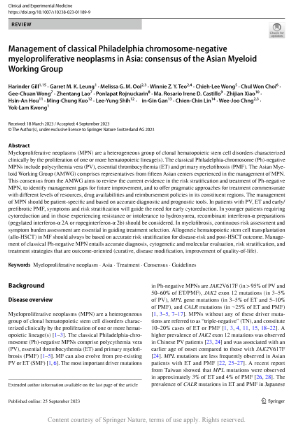
Management of Classical Philadelphia Chromosome‑Negative Myeloproliferative Neoplasms in Asia: Consensus of the Asian Myeloid Working Group
Myeloproliferative neoplasms (MPN) are a heterogeneous group of clonal hematopoietic stem cell disorders characterized clinically by the proliferation of one or more hematopoietic lineage(s). The classical Philadelphia-chromosome (Ph)-negative MPNs include polycythemia vera (PV), essential thrombocythemia (ET) and primary myelofibrosis (PMF).
This consensus from the AMWG aims to review the current evidence in the risk stratification and treatment of Ph-negative MPN, to identify management gaps for future improvement, and to offer pragmatic approaches for treatment commensurate with different levels of resources, drug availabilities and reimbursement policies in its constituent regions.
Read More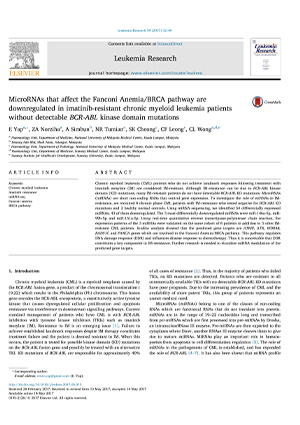
MicroRNAs That Affect the Fanconi Anemia/ BRCA Pathway are Downregulated in Imatinib-Resistant Chronic Myeloid Leukemia Patients Without Detectable BCR-ABL Kinase Domain Mutations
Chronic myeloid leukaemia (CML) patients who do not achieve landmark responses following treatment with imatinib mesylate (IM) are considered IM-resistant. Although IM-resistance can be due to BCR-ABL kinase domain (KD) mutations, many IM-resistant patients do not have detectable BCR-ABL KD mutations.
To investigate the role of miRNAs in IM-resistance, we recruited 8 chronic phase CML patients with IM-resistance who tested negative for BCR-ABL KD mutations and 2 healthy normal controls.
Read More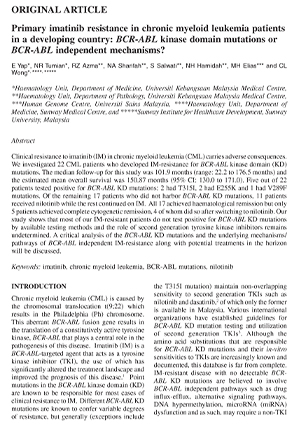
Primary imatinib resistance in chronic myeloid leukaemia patients in a developing country
Imatinib (IM) is a BCR-ABL-targeted agent that acts as a tyrosine kinase inhibitor (TKI), the use of which has significantly altered the treatment landscape and improved the prognosis of this disease. Point mutations in the BCR-ABL kinase domain (KD) are known to be responsible for most cases of clinical resistance to IM.
In this study, we retrospectively analyzed the clinical behaviour of 22 IM-resistant CML patients with and without BCR-ABL KD mutations.
Read More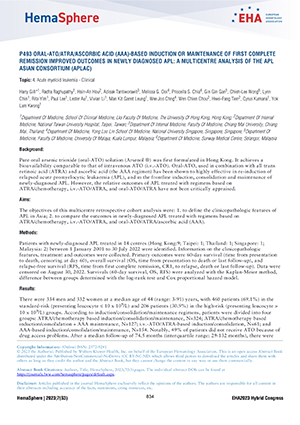
P493 Oral-ATO/ ATRA/ Ascorbic Acid (AAA)-Based Induction or Maintenance of First Complete Remission Improved Outcomes in Newly Diagnosed APL
Pure oral arsenic trioxide (oral-ATO) solution (Arsenol ®) was first formulated in Hong Kong. It achieves a bioavailability comparable to that of intravenous ATO (i.v.-ATO). Oral-ATO, used in combination with all trans retinoic acid (ATRA) and ascorbic acid (the AAA regimen) has been shown to be highly effective in the re-induction of relapsed acute promyelocytic leukaemia (APL), and in the frontline induction, consolidation and maintenance of newly-diagnosed APL.
Read More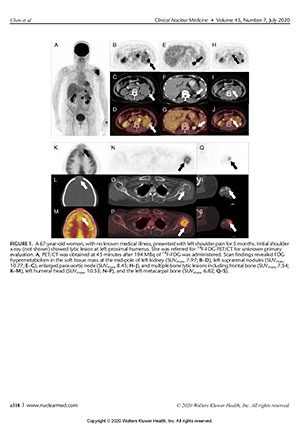
Ga-PSMA PET/CT and F-FDG PET/CT
Recent case reports and series have demonstrated the usefulness of 68Ga/18F-PSMA PET/CT in restaging recurrent renal cancer after nephrectomy. We presented a case of a patient with renal mass who had undergone both 18F-FDG and 68Ga-PSMA PET/CT for diagnosis and staging.
Concordant tracer uptake in the primary tumor and metastatic lesions was demonstrated by both radiotracers. Final histopathological reports revealed clear cell renal cell carcinoma. Furthermore, unusual left metacarpal bone metastasis was also detected.
Read More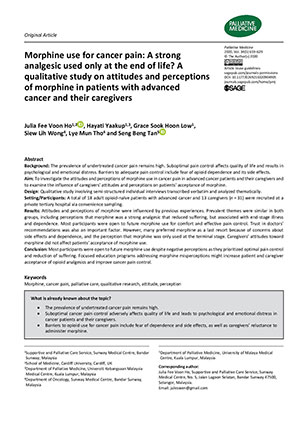
Morphine use for cancer pain
The incidence of pain has been reported to be over 50% in cancer patients in general and more than 90% in those with advanced cancer. Additionally, undertreated cancer pain occurs in 43% of cancer patients, with greater patient-perceived barriers to cancer pain management in Asian patients.
Suboptimal pain control affects the daily activities of cancer patients and their caregivers and changes the focus of their relationship. This can further result in psychological and emotional distress.
Read More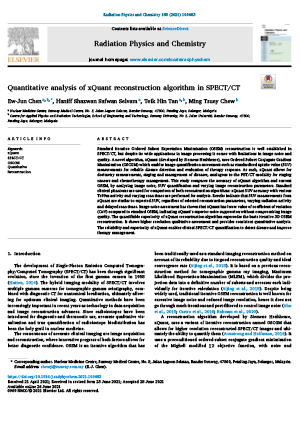
Quantitative analysis of xQuant reconstruction algorithm in SPECT/CT
OSEM is an iterative algorithm that has been traditionally used as a standard imaging reconstruction method on account of its reliability due to its good reconstruction quality and ideal convergence rate.
A reconstruction algorithm developed by Siemens Healthcare, xQuant, uses a variant of iterative reconstruction named OSCGM that allows for higher resolution reconstructed SPECT/CT images and ultimately the ability to quantify them.
This study compares the accuracy of the novel xQuant reconstruction algorithm against the current standard OSEM.
Read More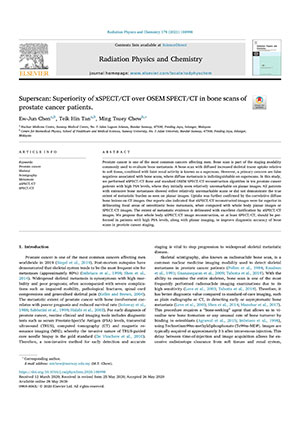
Superscan: Superiority of xSPECT/CT over OSEM SPECT/CT in bone scans of prostate cancer patients.
Prostate cancer is one of the most common cancers affecting men. Bone scan is part of the staging modality commonly used to evaluate bone metastasis. A bone scan with diffused increased skeletal tracer uptake relative to soft tissue, combined with faint renal activity is known as a superscan.
Read More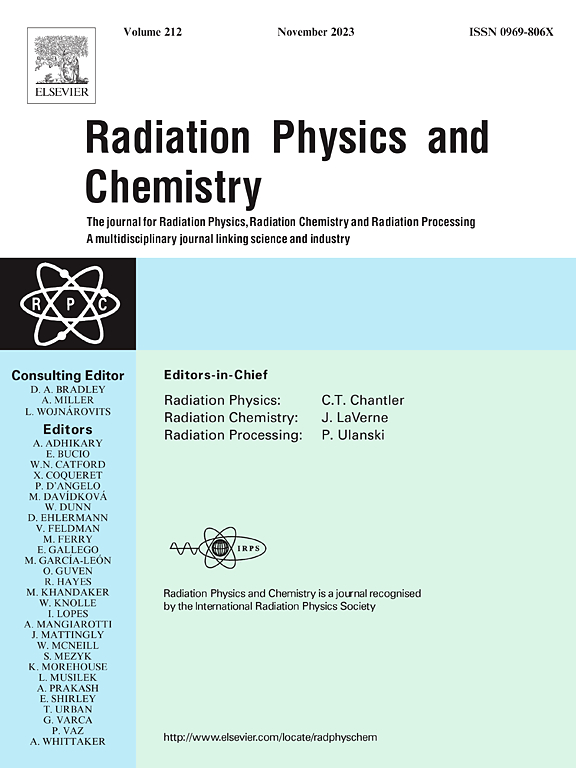
The Journal for Radiation Physics, Radiation Chemistry and Radiation Processing
Radiation Physics and Chemistry is a multidisciplinary journal that provides a medium for publication of substantial and original papers, reviews, and short communications which focus on research and developments involving ionizing radiation in radiation physics, radiation chemistry and radiation processing.
Read MoreCancer News
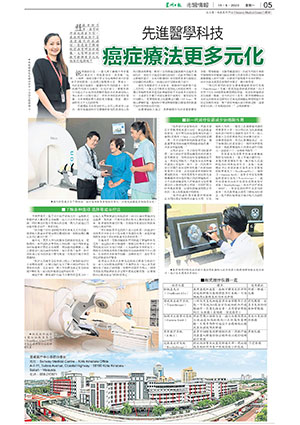
Advanced Medical Technology for More Diverse Cancer Treatments
Advanced Medical Technology for More Diverse Cancer Treatments
Read More

Cancer: A Time Bomb
Cancer was not a common disease but today, various cancers are leading patients to their end. This situation is influenced by financial constraints among the low income groups (B40), allowing them to only seek treatment when they are already at Stage 3 or 4 of the disease.
Read More
Cancer in Children
Cancer in children is rare, but parents cannot afford to take this disease lightly. In the United States, as many as 15,600 new cases involve cancer among children and adolescents between the ages of 0 and 19.
Read More
Cancer | Illustrations | Sunway Medical Centre
People tend to have a negative perception on hospitals – indifferent white treatment rooms, the pungent smell of antiseptic and unsettling emotions of fear, anxiety and sadness.
Read More
Combining Eastern and Western approaches
Sunway Group Healthcare has opened its first traditional and complementary medicine (TCM) centre at Sunway Geo Avenue in Bandar Sunway. Representing a holistic approach to medicine and health, Sunway TCM Centre aims to pair the traditional and cultural practices of the East with the modern, technology-driven approach of the West.
Read More
High incidence of cancer in an ageing society
High incidence of cancer in an ageing society
Read More
Introduction of an anti-cancer weapon
According to the World Health Organization (WHO), cancer is the second leading cause of death worldwide causing an estimated 9.6 million deaths in 2018 – that makes one out of every six deaths occurring from cancer.
Read More
Neoadjuvant Chemotherapy | Chemotherapy | Breast Cancer | Sunway Medical Centre
Blogpost. Articles and news about health and wellness. Community Happenings. View upcoming events in and outside of SunMed. QUIT Smoking. We offer private and personalised consultations
Read More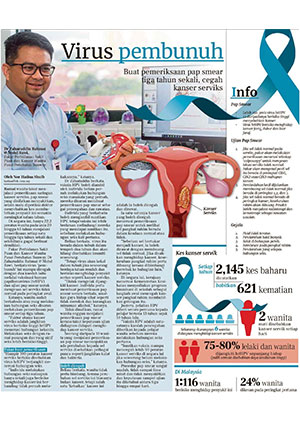
Preventing Cervical Cancer
In Malaysia, only 22.2% of women aged between 20 and 65 have their cervical cancer screening every one to three years, while the rest fail to do so.
Read More
Radiotherapy masks transformed into hero masks
Radiotherapy is mandatory for many cancer patients and for patients with head and neck cancer, they are required to have a thermoplastic mask securely attached to their head while undergoing radiotherapy.
Read More
Taking steps to up cancer fight
Cancer is the fourth most common cause of death in Malaysia, with approximately 37,000 cases reported every year. It is estimated that this number will rise to more than 55,000 newly-diagnosed cases by 2030.
Read More